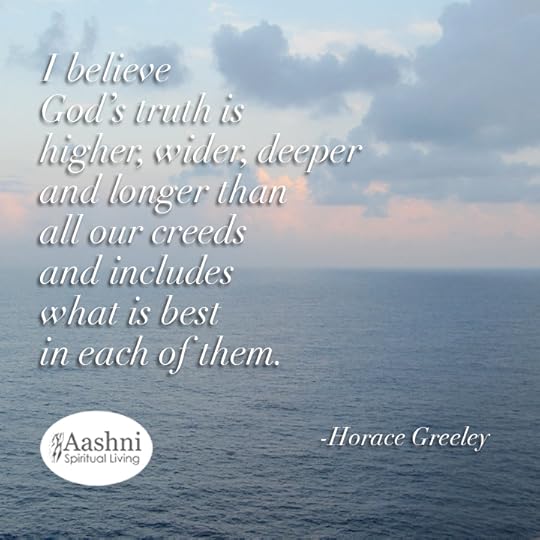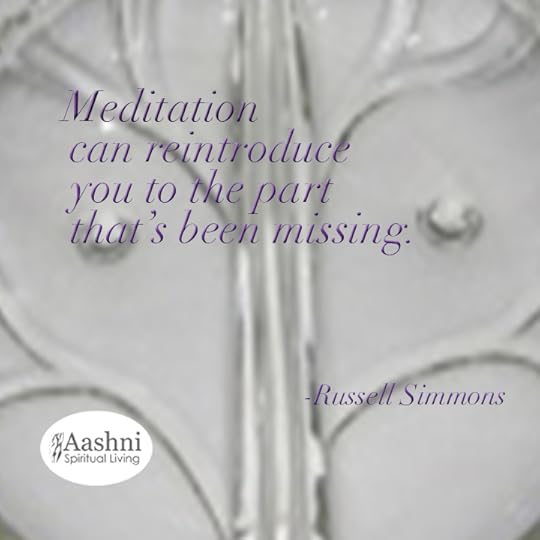Mischa V. Alyea's Blog, page 6
August 1, 2015
I believe God’s truth is
I believe God’s truth is
higher, wider, deeper and longer than
all our creeds and includes
what is best in each of them.
-Horace Greeley


July 29, 2015
Ego
July 27, 2015
I Believe in the Fundamental Truth
July 25, 2015
Meditation can reintroduce you
Meditation
can reintroduce you to the part
that’s been missing.
-Russell Simmons
 Meditation can reintroduce you
Meditation can reintroduce you

July 22, 2015
Accept what is,
July 19, 2015
If you truly loved yourself
July 17, 2015
The Thing about Meditation is . . .
June 22, 2015
The Statue of Liberty show us how The One can embrace the many

The Statue of Liberty has an honored place in the hearts of Americans. She evokes a sentiment that is derived from her multifaceted symbolism. She bears a torch, which is the symbol of fire and passion. She carries a book that represents knowledge and learning. She wears the sun-rayed crown that defines her as achieving the peak of enlightenment. She stands upon an eight-pointed star a symbol of the night, which gives balance to the sun of the day. Her dress is like a ripple of water flowing down her body. Her inner structure contains an elevator to the lookout at the forehead.
Yet, we do not find groups of people who carve up the statue into its component parts and identify with only one symbol to the exclusion of all the others. There are not the People of the Torch vs. the People of the Book. There are not the People of the Star vs. the People of the Sun. There are not the People of the Flowing Water vs. the People of the Elevator. We do not have conflict over THE ONE TRUE Statue of Liberty.
We understand that this statue is inclusive. It includes the ideals of the torch, the sun-rayed crown, the book, the star, the flowing water and the elevator. While there is only one Statue of Liberty, there is something for everyone in this figure.
Wouldn’t it be nice if God and religion could be viewed in this inclusive manner? Paul F. Knitter coined the phrase ‘Unitive Pluralism’ to describe this style of spiritual philosophy. The problem is that the world religions have identified the pieces, but they cannot see that what they hold is a piece of the puzzle that is God. They are clinging tightly to their personal viewpoint while condemning all others.
Worshiping God from only one viewpoint is like listening to a symphony that contains only one instrument. The richness of the complex integration contained in a diverse number of instruments working together to provide a whole experience is lost.
When each group declares its vision of the divine as THE ONE TRUE GOD, then we can look forward to unending conflict within each religion and between the belief systems of the world. However, if we can all see that each religion or spiritual viewpoint contains a valid and necessary piece of the puzzle that is God, then unity within diversity can prevail.

Statue of Liberty – A Study in Unitive Pluralism

The Statue of Liberty has an honored place in the hearts of Americans. She evokes a sentiment that is derived from her multifaceted symbolism. She bears a torch, which is the symbol of fire and passion. She carries a book that represents knowledge and learning. She wears the sun-rayed crown that defines her as achieving the peak of enlightenment. She stands upon an eight-pointed star a symbol of the night, which gives balance to the sun of the day. Her dress is like a ripple of water flowing down her body. Her inner structure contains an elevator to the lookout at the forehead.
Yet, we do not find groups of people who carve up the statue into its component parts and identify with only one symbol to the exclusion of all the others. There are not the People of the Torch vs. the People of the Book. There are not the People of the Star vs. the People of the Sun. There are not the People of the Flowing Water vs. the People of the Elevator. We do not have conflict over THE ONE TRUE Statue of Liberty.
We understand that this statue is inclusive. It includes the ideals of the torch, the sun-rayed crown, the book, the star, the flowing water and the elevator. While there is only one Statue of Liberty, there is something for everyone in this figure.
Wouldn’t it be nice if God and religion could be viewed in this inclusive manner? Paul F. Knitter coined the phrase ‘Unitive Pluralism’ to describe this style of spiritual philosophy. The problem is that the world religions have identified the pieces, but they cannot see that what they hold is a piece of the puzzle that is God. They are clinging tightly to their personal viewpoint while condemning all others.
Worshiping God from only one viewpoint is like listening to a symphony that contains only one instrument. The richness of the complex integration contained in a diverse number of instruments working together to provide a whole experience is lost.
When each group declares its vision of the divine as THE ONE TRUE GOD, then we can look forward to unending conflict within each religion and between the belief systems of the world. However, if we can all see that each religion or spiritual viewpoint contains a valid and necessary piece of the puzzle that is God, then unity within diversity can prevail.




 cc
cc




